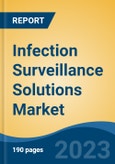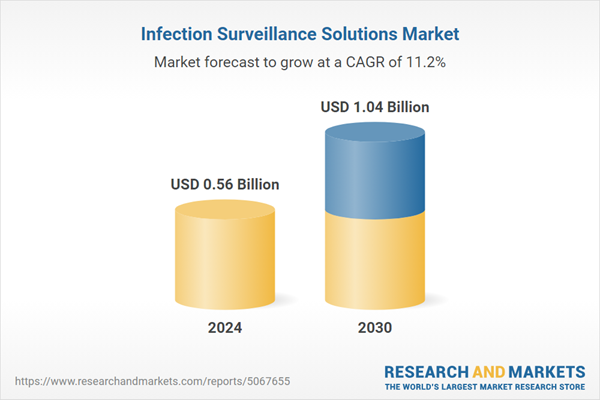Speak directly to the analyst to clarify any post sales queries you may have.
10% Free customizationThis report comes with 10% free customization, enabling you to add data that meets your specific business needs.
For instance, in 2024, a study analyzing U.S. hospital data revealed that hospital-acquired infections linked to antimicrobial resistance (AMR) rose by 32% during the COVID-19 pandemic and remain 13% higher post-pandemic compared to pre-pandemic levels. The findings underscore the lasting impact of the pandemic on AMR and the need for sustained infection control and antimicrobial stewardship.
Common examples of HAIs include pneumonia, gastrointestinal illness, urinary tract infections, primary bloodstream infections, and post-surgical infections. The high incidence of HAIs is a significant concern for governments worldwide, leading to the development of policies aimed at effectively managing and reducing these incidents. According to the UK Health Security Agency's 2025 report, healthcare-associated infections were found in 7.6% of patients - marking a 1% rise compared to 2016. The survey highlights a concerning upward trend, emphasizing the need for strengthened infection prevention and control measures across healthcare settings in the UK.
Key Market Drivers
Increasing Prevalence of Hospital-Acquired Infections
The increasing prevalence of hospital-acquired infections (HAIs) is driving the demand for infection surveillance solutions. Hospital-acquired infections, also known as healthcare-associated infections, are infections that patients acquire while receiving medical treatment in healthcare facilities. These infections can lead to prolonged hospital stays, increased healthcare costs, patient discomfort, and, in severe cases, even mortality. In response to this growing concern, infection surveillance solutions are being sought after to help prevent, monitor, and manage HAIs. HAIs pose a significant threat to patient safety and well-being.The rising awareness of these concerns has prompted healthcare facilities to prioritize infection control. For instance, in 2024, healthcare-associated infections impact approximately 4.3 million patients annually in hospitals across the EU/EEA. These infections pose significant challenges to patient safety, increase hospital stays, and contribute to higher healthcare costs. Reducing their incidence remains a critical priority for healthcare systems, requiring improved infection control practices and enhanced surveillance measures throughout the region.
The increasing emphasis on hospital safety is driving the market for infection control surveillance solutions. Hospitals are actively seeking ways to enhance patient safety and reduce infection rates through improved surveillance strategies. This transformation commenced in the late 2000s with the introduction of electronic medical record systems, which allowed for more efficient and accurate patient data collection. Presently, hospitals are investing in advanced solutions to detect and predict infections, implement evidence-based protocols, and monitor outcomes over time. These solutions leverage data analytics, AI, ML, and predictive modeling to facilitate accurate identification and mitigation of infection risks. Apart from enhancing patient safety, these solutions offer potential benefits such as cost reduction, operational efficiency improvement, and optimization of care quality.
Key Market Challenges
High Cost of Deployment for Small Healthcare Organizations
The high cost of deployment for small healthcare organizations is a significant factor restraining the growth of Infection Surveillance Solutions (ISS). These solutions often require initial investment in technology, infrastructure, staff training, and ongoing maintenance. For small healthcare organizations with limited budgets and resources, the cost of implementing and sustaining infection surveillance solutions can be a barrier to adoption. Small healthcare organizations often operate with tighter budgets compared to larger institutions. The high upfront and ongoing costs associated with infection surveillance solutions can strain their financial resources, making it difficult to allocate funds for implementation.Small healthcare organizations may need to prioritize their resources for essential services and treatments. Investing in infection surveillance solutions might divert resources away from other critical needs, making the decision challenging. Beyond the initial deployment, infection surveillance solutions require ongoing maintenance, updates, and technical support. Small healthcare organizations might struggle to allocate resources for these continuous operational needs.
Key Market Trends
Cloud-based Software Solutions
Cloud-based software solutions are expected to significantly boost the Infection Surveillance Solutions (ISS) market in the future. Cloud technology offers a range of benefits that align well with the needs of healthcare organizations seeking efficient and scalable infection surveillance solutions. For instance, according to a 2022 article, 94% of companies worldwide have adopted cloud computing. This widespread adoption reflects the growing reliance on cloud-based technologies to enhance scalability, improve efficiency, and support digital transformation across various industries, making cloud computing a critical component of modern business operations.Cloud-based solutions offer scalability to accommodate the varying needs of healthcare organizations, whether they are small clinics or large hospitals. As the demand for infection surveillance solutions grows, cloud platforms can easily scale up to handle increased data volume and user activity. Traditional on-premises software solutions require significant investments in hardware, servers, and IT infrastructure. Cloud-based solutions eliminate these upfront costs, making ISS more accessible to healthcare organizations with limited resources. Cloud-based solutions are typically quicker to implement compared to on-premises alternatives.
This is particularly advantageous for healthcare organizations looking to deploy infection surveillance solutions rapidly. Cloud-based solutions provide remote access to infection surveillance data for authorized personnel. Healthcare professionals can securely access and monitor infection data from various locations, enabling more efficient and timely interventions. Cloud-based infection surveillance solutions enable real-time monitoring of infection trends, allowing healthcare organizations to respond promptly to potential outbreaks and implement necessary interventions.
Key Market Players
- Cerner Corporation
- Epic Systems Corporation
- VigiLanz Corporation
- Becton, Dickinson and Company
- Premier Inc.
- DEB Group Ltd
- RL Solutions
- Baxter International Inc. (ICNet International)
- Gojo Industries Inc.
- IBM Corporation (Truven Health Analytics)
Report Scope:
In this report, the Global Infection Surveillance Solutions Market has been segmented into the following categories, in addition to the industry trends which have also been detailed below:Infection Surveillance Solutions Market, By Offering:
- Software
- Service
Infection Surveillance Solutions Market, By End User:
- Hospitals
- Long-term Care Facilities
Infection Surveillance Solutions Market, By Region:
- North America
- United States
- Canada
- Mexico
- Europe
- France
- United Kingdom
- Italy
- Germany
- Spain
- Asia-Pacific
- China
- India
- Japan
- Australia
- South Korea
- South America
- Brazil
- Argentina
- Colombia
- Middle East & Africa
- South Africa
- Saudi Arabia
- UAE
Available Customizations:
With the given market data, the publisher offers customizations according to a company's specific needs. The following customization options are available for the report.Company Information
- Detailed analysis and profiling of additional market players (up to five).
This product will be delivered within 1-3 business days.
Table of Contents
Companies Mentioned
- Cerner Corporation
- Epic Systems Corporation
- VigiLanz Corporation
- Becton, Dickinson and Company
- Premier Inc.
- DEB Group Ltd
- RL Solutions
- Baxter International Inc. (ICNet International)
- Gojo Industries Inc.
- IBM Corporation (Truven Health Analytics)
Table Information
| Report Attribute | Details |
|---|---|
| No. of Pages | 185 |
| Published | August 2025 |
| Forecast Period | 2024 - 2030 |
| Estimated Market Value ( USD | $ 0.56 Billion |
| Forecasted Market Value ( USD | $ 1.04 Billion |
| Compound Annual Growth Rate | 11.1% |
| Regions Covered | Global |
| No. of Companies Mentioned | 10 |









